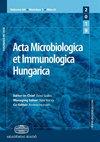Antibiotic resistant Escherichia coli strains in healthy pets from Tamaulipas, Mexico.
IF 1.6
4区 医学
Q4 IMMUNOLOGY
引用次数: 0
Abstract
Antibiotic resistance constitutes a significant public health challenge, with diverse reservoirs of resistant bacteria playing pivotal roles in their dissemination. Among these reservoirs, pets are carrying antibiotic-resistant strains. The objective of this study was to assess the resistance profiles of Escherichia coli, and the prevalence of extended-spectrum β-lactamase (ESBL) producing E. coli strains in dogs and cats from Tamaulipas, Mexico. A total of 300 stool samples (150 dogs and 150 cats) from healthy pets were subjected to analysis. Antibiotic susceptibility testing and the identification of ESBLs were carried out by disc diffusion method. The presence of resistance genes, class 1, 2, and 3 integrons (intI1, intI2, and intI3) and phylogroups was determined by PCR analysis. The findings reveal that 42.6% (128/300) of the strains exhibited resistance to at least one of the eight antibiotics assessed, and 18.6% (56/300) demonstrated multidrug resistance (MDR), that distributed across 69 distinct resistance patterns. Altogether 2.6% of E. coli strains (8/300) were confirmed as TEM and CTX-M type ESBL producers. These outcomes underscore the roles of dogs and cats in Tamaulipas as reservoirs for the dissemination of MDR and/or ESBL strains. The results underscore the necessity for conducting prevalence studies on ESBL-producing E. coli, forming a foundation for comprehending the present scenario and formulating strategies for the control and mitigation of this issue.墨西哥塔毛利帕斯州健康宠物中的抗生素耐药大肠杆菌菌株。
抗生素耐药性是一项重大的公共卫生挑战,各种耐药性细菌库在其传播过程中发挥着关键作用。在这些蓄水池中,宠物携带着抗生素耐药菌株。本研究旨在评估墨西哥塔毛利帕斯州猫狗中大肠埃希菌的耐药性概况以及产生广谱β-内酰胺酶(ESBL)的大肠埃希菌菌株的流行情况。共对 300 份健康宠物的粪便样本(150 份狗样本和 150 份猫样本)进行了分析。抗生素敏感性测试和 ESBLs 的鉴定是通过盘扩散法进行的。耐药性基因、1、2 和 3 类整合子(intI1、intI2 和 intI3)以及系统群的存在情况则通过 PCR 分析来确定。研究结果显示,42.6%(128/300)的菌株对所评估的八种抗生素中的至少一种表现出耐药性,18.6%(56/300)的菌株表现出多药耐药性(MDR),分布在 69 种不同的耐药性模式中。共有 2.6% 的大肠杆菌菌株(8/300)被确认为 TEM 和 CTX-M 型 ESBL 生产者。这些结果表明,在塔毛利帕斯州,猫狗是 MDR 和/或 ESBL 菌株传播的 "蓄水池"。这些结果表明,有必要对产 ESBL 大肠杆菌进行流行率研究,从而为了解目前的情况以及制定控制和缓解这一问题的策略奠定基础。
本文章由计算机程序翻译,如有差异,请以英文原文为准。
求助全文
约1分钟内获得全文
求助全文
来源期刊

Acta microbiologica et immunologica Hungarica
IMMUNOLOGY-MICROBIOLOGY
CiteScore
2.30
自引率
13.30%
发文量
36
审稿时长
>12 weeks
期刊介绍:
AMIH is devoted to the publication of research in all fields of medical microbiology (bacteriology, virology, parasitology, mycology); immunology of infectious diseases and study of the microbiome related to human diseases.
 求助内容:
求助内容: 应助结果提醒方式:
应助结果提醒方式:


